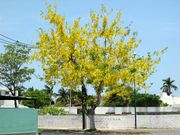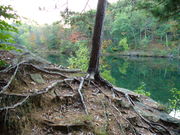Tree
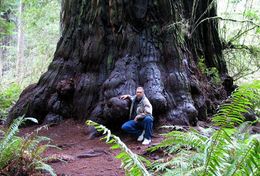
A tree is a perennial woody plant. It is most often defined as a woody plant that has many secondary branches supported clear of the ground on a single main stem or trunk with clear apical dominance.[1] A minimum height specification at maturity is cited by some authors, varying from 3 m[2] to 6 m;[3] some authors set a minimum of 10 cm trunk diameter (30 cm girth).[4] Woody plants that do not meet these definitions by having multiple stems and/or small size are called shrubs. Compared with most other plants, trees are long-lived, some reaching several thousand years old and growing to up to 115 m (379 ft) high.[5]
Trees are an important component of the natural landscape because of their prevention of erosion and the provision of a weather-sheltered ecosystem in and under their foliage. They also play an important role in producing oxygen and reducing carbon dioxide in the atmosphere, as well as moderating ground temperatures. They are also elements in landscaping and agriculture, both for their aesthetic appeal and their orchard crops (such as apples). Wood from trees is a building material, as well as a primary energy source in many developing countries. Trees also play a role in many of the world's mythologies (see trees in mythology).[6]
Contents |
Classification
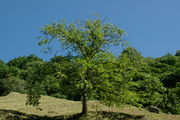
A tree is a plant form that occurs in many different orders and families of plants. Trees show a variety of growth forms, leaf type and shape, bark characteristics and reproductive organs.
The tree form has evolved separately in unrelated classes of plants, in response to similar environmental challenges, making it a classic example of parallel evolution. With an estimate of 100,000 tree species, the number of tree species worldwide might total 25 percent of all living plant species.[7] The majority of tree species grow in tropical regions of the world and many of these areas have not been surveyed yet by botanists, making species diversity and ranges poorly understood.[8]
The earliest trees were tree ferns, horsetails and lycophytes, which grew in forests in the Carboniferous period; tree ferns still survive, but the only surviving horsetails and lycophytes are not of tree form. Later, in the Triassic period, conifers, ginkgos, cycads and other gymnosperms appeared, and subsequently flowering plants in the Cretaceous period. Most species of trees today are flowering plants (Angiosperms) and conifers. For the listing of examples of well-known trees and how they are classified, see List of tree genera.
A small group of trees growing together is called a grove or copse, and a landscape covered by a dense growth of trees is called a forest. Several biotopes are defined largely by the trees that inhabit them; examples are rainforest and taiga (see ecozones). A landscape of trees scattered or spaced across grassland (usually grazed or burned over periodically) is called a savanna. A forest of great age is called old growth forest or ancient woodland (in the UK). A young tree is called a sapling.
Morphology

The parts of a tree are the roots, trunk(s), branches, twigs and leaves. Tree stems consist mainly of support and transport tissues (xylem and phloem). Wood consists of xylem cells, and bark is made of phloem and other tissues external to the vascular cambium. Trees may be grouped into exogenous and endogenous trees according to the way in which their stem diameter increases. Exogenous trees, which comprise the great majority of trees (all conifers, and almost all broadleaf trees), grow by the addition of new wood outwards, immediately under the bark. Endogenous trees, mainly in the monocotyledons (e.g., palms and dragon trees), but also cacti, grow by addition of new material inwards.
As an exogenous tree grows, it creates growth rings as new wood is laid down concentrically over the old wood. In species growing in areas with seasonal climate changes, wood growth produced at different times of the year may be visible as alternating light and dark, or soft and hard, rings of wood.[3] In temperate climates, and tropical climates with a single wet-dry season alternation, the growth rings are annual, each pair of light and dark rings being one year of growth; these are known as annual rings. In areas with two wet and dry seasons each year, there may be two pairs of light and dark rings each year; and in some (mainly semi-desert regions with irregular rainfall), there may be a new growth ring with each rainfall.[9] In tropical rainforest regions, with constant year-round climate, growth is continuous and the growth rings are not visible nor is there a change in the wood texture. In species with annual rings, these rings can be counted to determine the age of the tree, and used to date cores or even wood taken from trees in the past, a practice known as the science of dendrochronology. Very few tropical trees can be accurately dated in this manner. Age determination is also impossible in endogenous trees.
The roots of a tree are generally embedded in earth, providing anchorage for the above-ground biomass and absorbing water and nutrients from the soil. However, while ground nutrients are essential to a tree's growth the majority of its biomass comes from carbon dioxide absorbed from the atmosphere (see photosynthesis). Above ground, the trunk gives height to the leaf-bearing branches, aiding in competition with other plant species for sunlight. In many trees, the arrangement of the branches optimizes exposure of the leaves to sunlight.
Not all trees have all the plant organs or parts mentioned above. For example, most palm trees are not branched, the saguaro cactus of North America has no functional leaves, tree ferns do not produce bark, etc. Based on their general shape and size, all of these are nonetheless generally regarded as trees. A plant form that is similar to a tree, but generally having smaller, multiple trunks and/or branches that arise near the ground, is called a shrub. However, no precise differentiation between shrubs and trees is possible. Given their small size, bonsai plants would not technically be 'trees', but one should not confuse reference to the form of a species with the size or shape of individual specimens. A spruce seedling does not fit the definition of a tree, but all spruces are trees.
Record breaking trees
The world's champion trees can be rated on height, trunk diameter or girth, total size, and age.
Tallest trees
The heights of the tallest trees in the world have been the subject of considerable dispute and much exaggeration. Modern verified measurements with laser rangefinders, other measuring devices, or with tape drop measurements made by tree climbers (such as those carried out by canopy researchers or members of groups like the U.S. Eastern Native Tree Society), have shown that some older measuring methods and measurements are often unreliable, sometimes producing exaggerations of 5% to 15% or more above the real height. Historical claims of trees growing to 130 m (427 ft), and even 150 m (492 ft), are now largely disregarded as unreliable, and attributed to human error. Historical records of fallen trees measured prostrate on the ground are considered to be somewhat more reliable. The following are now accepted as the top ten tallest reliably measured species:
- Coast Redwood (Sequoia sempervirens): 115.56 m (379.1 ft), Redwood National Park, California, United States[10]
- Australian Mountain-ash (Eucalyptus regnans): 99.6 m (326.8 ft), south of Hobart, Tasmania, Australia[11]
- Coast Douglas-fir (Pseudotsuga menziesii): 99.4 m (326.1 ft), Brummit Creek, Coos County, Oregon, United States[12]
- Sitka Spruce (Picea sitchensis): 96.7 m (317.3 ft), Prairie Creek Redwoods State Park, California, United States[13]
- Giant Sequoia (Sequoiadendron giganteum): 94.9 m (311.4 ft), Redwood Mountain Grove, Kings Canyon National Park, California, United States[14]
- Tasmanian Blue Gum (Eucalyptus globulus): 90.7 m (297.6 ft), Tasmania, Australia[15]
- Manna Gum (Eucalyptus viminalis): 89 m (292 ft), Evercreech Forest Reserve, Tasmania, Australia[15]
- Shorea faguetiana: 88.3 m (289.7 ft) Tawau Hills National Park, in Sabah on the island of Borneo[16]
- Alpine Ash (Eucalyptus delegatensis): 87.9 m (288.4 ft), Tasmania, Australia[15]
- Noble Fir (Abies procera): 87.5 m (287.1 ft) Mount St. Helens National Volcanic Monument, Washington, United States[17][18]
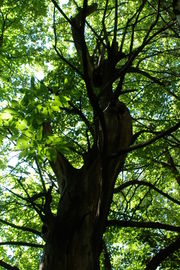
Stoutest trees
The girth of a tree is usually much easier to measure than the height, as it is a simple matter of stretching a tape round the trunk, and pulling it taut to find the circumference. Despite this, UK tree author Alan Mitchell made the following comment about measurements of yew trees:
The aberrations of past measurements of yews are beyond belief. For example, the tree at Tisbury has a well-defined, clean, if irregular bole at least 1.5 m long. It has been found to have a girth that dilated and shrunk in the following way: 11.28 m (1834 Loudon), 9.3 m (1892 Lowe), 10.67 m (1903 Elwes and Henry), 9.0 m (1924 E. Swanton), 9.45 m (1959 Mitchell) ... Earlier measurements have therefore been omitted."
As a general standard, tree girth is taken at 'breast height'. This is cited as dbh (diameter at breast height) in tree and forestry literature.[3][19] Breast height is defined differently in different situations, with most forestry measurements taking girth at 1.3 m above ground,[19] while those who measure ornamental trees usually measure at 1.5 m above ground;[3] in most cases this makes little difference to the measured girth. On sloping ground, the "above ground" reference point is usually taken as the highest point on the ground touching the trunk,[3][19] but some use the average between the highest and lowest points of ground. Some of the inflated old measurements may have been taken at ground level. Some past exaggerated measurements also result from measuring the complete next-to-bark measurement, pushing the tape in and out over every crevice and buttress.[20]
Modern trends are to cite the tree's diameter rather than the circumference. Diameter of the tree is calculated by finding the medium diameter of the trunk, in most cases obtained by dividing the measured circumference by π; this assumes the trunk is mostly circular in cross-section (an oval or irregular cross-section would result in a mean diameter slightly greater than the assumed circle). Accurately measuring circumference or diameter is difficult in species with the large buttresses that are especially characteristic in many species of rainforest trees. Simple measurement of circumference of such trees can be misleading when the circumference includes much empty space between buttresses.
One further problem with measuring baobabs Adansonia is that these trees store large amounts of water in the very soft wood in their trunks. This leads to marked variation in their girth over the year (though not more than about 2.5%[21]), swelling to a maximum at the end of the rainy season, minimum at the end of the dry season.
The stoutest living single-trunk species in diameter are:
- African Baobab Adansonia digitata: 15.9 m (52 ft), Glencoe Baobab (measured near the ground), Limpopo Province, South Africa.[22]. This tree split up in November 2009 and now the stoutest baobab could be Sunland Baobab (South Africa) with idealised diameter 10.64 m and correct circumference - 33.4 m.
- Montezuma Cypress Taxodium mucronatum: 11.62 m (38.1 ft), Árbol del Tule, Santa Maria del Tule, Oaxaca, Mexico.[23] Note though that this diameter includes buttressing; the actual idealised diameter of the area of its wood is 9.38 m (30.8 ft).[23]
- Giant Sequoia Sequoiadendron giganteum: 8.85 m (29 ft), General Grant tree, General Grant Grove, California, United States[24]
- Coast Redwood Sequoia sempervirens: 7.9 m (25.9 ft), Lost Monarch Jedediah Smith Redwoods State Park, California, United States.
- Australian Oak Eucalyptus obliqua: 6.72 m (22 ft)
- Australian Mountain-ash Eucalyptus regnans: 6.52 m (21.4 ft), Big Foot
- Western Redcedar Thuja plicata: 5.99 m (19.7 ft), Kalaloch Cedar, Olympic National Park
- Sitka Spruce Picea sitchensis: 5.39 m (17.7 ft), Quinalt Lake Spruce, Olympic National Park
- Alerce Fitzroya cupressoides: 5.0 m (16.4 ft)
An additional problem lies in instances where multiple trunks (whether from an individual tree or multiple trees) grow together. The Sacred Fig is a notable example of this, forming additional 'trunks' by growing adventitious roots down from the branches, which then thicken up when the root reaches the ground to form new trunks; a single Sacred Fig tree can have hundreds of such trunks.[1]
Largest trees
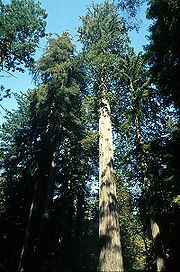
The largest trees in total volume are both tall and large in diameter and, in particular, hold a large diameter high up the trunk. Measurement is very complex, particularly if branch volume is to be included as well as the trunk volume, so measurements have only been made for a small number of trees, and generally only for the trunk. No attempt has ever been made to include root volume. Measuring standards vary.
The top ten species measured so far are*:
- Giant Sequoia Sequoiadendron giganteum: 1,487 m³ (52,508 cu ft), General Sherman[25]
- Coast Redwood Sequoia sempervirens: 1,203 m³ (42,500 cu ft), Lost Monarch[17]
- Montezuma Cypress Taxodium mucronatum: 750 m³ (25,000 cu ft), Árbol del Tule[26]
- Western Redcedar Thuja plicata: 500 m³ (17,650 cu ft ), Quinault Lake Redcedar[25]
- Tasmanian Blue Gum Eucalyptus globulus: 368 m³ (13,000 cu ft), Rullah Longatyle (Strong Girl, also Grieving Giant) [15]
- Australian Mountain-ash Eucalyptus regnans: 360 m³ (12,714 cu ft), Arve Big Tree[15]
- Coast Douglas-fir Pseudotsuga menziesii 349 m³ (12,320 cu ft) Red Creek Tree
- Sitka Spruce Picea sitchensis 337 m³ (11,920 cu ft) Queets Spruce
- Australian Oak Eucalyptus obliqua: 337 m³ (11,920 cu ft) Gothmog[15]
- Alpine Ash Eucalyptus delegatensis: 286 m³ (10,100 cu ft), located in Styx River Valley[15]
(*)This list does not take into account now dead specimens.
Smallest tree
Many fully grown mature trees may be very short due to environmental factors or disease. However healthy and well grown specimens of a few species of tree only reach a height of a few centimetres. Amongst these is Lepidothamnus laxifolius believed to be the shortest conifer in the world.
Oldest trees
The oldest trees are determined by growth rings, which can be seen if the tree is cut down, or in cores taken from the bark to the center of the tree. Accurate determination is only possible for trees that produce growth rings, generally those in seasonal climates. Trees in uniform non-seasonal tropical climates grow continuously and do not have distinct growth rings. It is also only possible for trees that are solid to the center. Many very old trees become hollow as the dead heartwood decays. For some of these species, age estimates have been made on the basis of extrapolating current growth rates, but the results are usually largely speculation. White (1998)[27] proposes a method of estimating the age of large and veteran trees in the United Kingdom through the correlation between a tree's stem diameter, growth character and age.
The verified oldest measured ages are:
- Great Basin Bristlecone Pine (Methuselah) Pinus longaeva: 4,844 years[28]
- Alerce Fitzroya cupressoides: 3,622 years[28]
- Giant Sequoia Sequoiadendron giganteum: 3,266 years[28]
- Sugi Cryptomeria japonica: 3,000 years[29]
- Huon-pine Lagarostrobos franklinii: 2,500 years[28]
Other species suspected of reaching exceptional age include European Yew Taxus baccata (probably over 2,000 years[30][31]) and Western Redcedar Thuja plicata. The oldest known European Yew is the Llangernyw Yew in the Churchyard of Llangernyw village in North Wales, which is estimated to be between 4,000 and 5,000 years old.
The oldest reported age for an angiosperm tree is 2293 years for the Sri Maha Bodhi Sacred Fig (Ficus religiosa) planted in 288 BC at Anuradhapura, Sri Lanka. This is also the oldest human-planted tree with a known planting date.
Damage
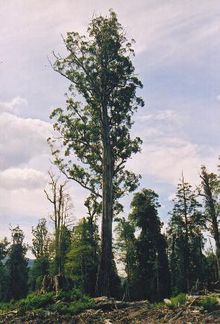
The two sources of tree damage are either biotic (from living sources) or abiotic (from non-living sources). Biotic sources include insects that bore into the tree, deer that rub bark off, and fungi.[32]
Abiotic sources include lightning, vehicles impacts, and construction activities. Construction activities can involve a number of damage sources, including grade changes that prevent aeration to roots, spills involving toxic chemicals such as cement or petroleum products, or severing of branches or roots.
Both damage sources can result in trees becoming dangerous, and the term "hazard trees" is commonly used by arborists, and industry groups such as power line operators. Hazard trees are trees that, due to disease or other factors, are more susceptible to falling in windstorms, or having parts of the tree fall.
Evaluating the danger a tree presents is based on a process called the Quantified Tree Risk Assessment.[33]
Assessment as to labeling a tree a hazard tree can be based on a field examination. Assessment as a result of construction activities that will damage a tree is based on three factors: severity, extent and duration. Severity relates usually to the degree of intrusion into the TPZ and resultant root loss. Extent is frequently a percentage of a factor such as canopy, roots or bark, and duration is normally based on time. Root severing is considered permanent in time.
Trees are similar to people. Both can withstand massive amounts of some types of damage and survive, but even small amounts of certain types of trauma can result in death. Arborists are very aware that established trees will not tolerate any appreciable disturbance of the root system.[34] However, lay people and construction professionals are seldom cognizant of how easily a tree can be killed.
One reason for confusion about tree damage from construction involves the dormancy of trees during winter. Another factor is that trees may not show symptoms of damage until 24 months or longer after damage has occurred. For that reason, persons uneducated in arboriculture science may not correlate the actual cause and resultant effect.
Various organizations, such as the International Society of Arboriculture, the British Standards Institute and the National Arborist Association (about 2007 renamed the Tree Industry Association), have long recognized the importance of construction activities that impact tree health. The impacts are important because they can result in monetary losses due to tree damage and resultant remediation or replacement costs, as well as violation of government ordinances or community or subdivision restrictions.
As a result, protocols for tree management prior to, during and after construction activities are well established, tested and refined. These basic steps are involved:
- Review of the construction plans
- Development of the related tree inventory
- Application of standard construction tree management protocols
- Assessment of potential for expected tree damages
- Development of a tree protection plan (providing for pre-, concurrent, and post construction damage prevention and remediation steps)
- Development of a tree protection plan
- Development of a remediation plan
- Implementation of tree protection zones (TPZ)
- Assessment of construction tree damage, post-construction
- Implementation of the remediation plan
International standards are uniform in analyzing damage potential and sizing TPZs (tree protection zones) to minimize damage. For mature to fully mature trees, the accepted TPZ comprises a 1.5-foot set-off for every 1 inch diameter of trunk. That means for a 10-inch tree, the TPZ would extend 15 feet in all directions from the base of the trunk at ground level.
For young or small trees with minimal crowns (and trunks less than 4 inches in diameter) a TPZ equal to 1 foot for every inch of trunk diameter may suffice. That means for a 3-inch tree, the TPZ would extend 3 feet in all directions from the base of the trunk at ground level. Detailed information on TPZs and related topics is available at minimal cost from organizations like the International Society for Arboriculture.
Trees in culture
The tree has always been a cultural symbol. Common icons are the World tree, for instance Yggdrasil,[35] and the tree of life. The tree is often used to represent nature or the environment itself. A common misconception is that trees get most of their mass from the ground.[36] In fact, 99% of a tree's mass comes from the air.[36]
Tree value estimation
Studies have shown that trees contribute as much as 27% of the appraised land value in certain markets.[37]
| diameter (inches) |
value (1985 US$) |
|---|---|
| 10 | $1,729 |
| 14 | $3,388 |
| 18 | $5,588 |
| 26 | $11,682 |
| 30 | $15,554 |
These most likely use diameter measured at breast height, 4.5 feet (140 cm) above ground—not the larger base diameter. A general model for any year and diameter is Value = 17.27939*( diameter ^2)*1.022^( year -1985) assuming 2.2% inflation per year.[39] (Note, the right side of this equation is written to paste into Excel or Google to perform the calculation.) Extrapolations from any model can cause problems, so tree value estimates for diameters larger than 30 inches might have to be capped so trees do not exceed 27% of the total appraised property value.
See also
- Arboretum
- Arboriculture
- Axel Erlandson
- Bonsai
- Christmas tree
- Deforestation
- Dendrology
- Dendrometry
- Evolution of plants#Evolution of trees
- Exploding tree
- Frost crack
- Fruit trees
- Gilroy Gardens
- John Krubsack
- List of famous trees
- List of tree genera
- List of trees and shrubs by taxonomic family
- Mother of the Forest
- Multipurpose tree
- Plantation
- Topiary
- Tree allometry
- Tree climbing
- Tree line
- Trees of the world
- Tree Shaping
- Urban forestry
- Woodland management
References
Notes
- ↑ 1.0 1.1 Huxley, A., ed. (1992). New RHS Dictionary of Gardening. Macmillan ISBN 0-333-47494-5.
- ↑ Rushforth, K. (1999). Trees of Britain and Europe. Collins ISBN 0-00-220013-9.
- ↑ 3.0 3.1 3.2 3.3 3.4 Mitchell, A. F. (1974). A Field Guide to the Trees of Britain and Northern Europe. Collins ISBN 0-00-212035-6
- ↑ Utkarsh Ghate. "Field Guide to Indian Trees, introductory chapter: Introduction to Common Indian Trees" (RTF). http://home.att.net/~spiderhunters/attachments/trintro.rtf. Retrieved 2007-07-25.
- ↑ Gymnosperm Database: Sequoia sempervirens
- ↑ Going Out On A Limb With A Tree-Person Ratio, Morning Edition, National Public Radio. 12 Nov 2008.
- ↑ "TreeBOL project". http://www.talkbx.com/2008/05/02/scientists-to-capture-tree-dna-worldwide/#more-835. Retrieved 2008-07-11.
- ↑ Friis, Ib, and Henrik Balslev. 2005. Plant diversity and complexity patterns: local, regional, and global dimensions : proceedings of an international symposium held at the Royal Danish Academy of Sciences and Letters in Copenhagen, Denmark, 25–28 May 2003. Biologiske skrifter, 55. Copenhagen: Royal Danish Academy of Sciences and Letters. pp 57-59.
- ↑ Mirov, N. T. (1967). The Genus Pinus. Ronald Press.
- ↑ "Gymnosperm Database: Sequoia sempervirens". http://www.conifers.org/cu/se/index.htm. Retrieved 2007-06-10. "Hyperion, Redwood National Park, CA, 115.55 m"
- ↑ "Tasmania's Ten Tallest Giants". Tasmanian Giant Trees Consultative Committee. http://www.gianttrees.com.au/tall.htm. Retrieved 2009-01-07. "Height (m): 99.6; Diameter (cm): 405; Species: E. regnans; Tree identification: TT443; Name: Centurion; Location: south of Hobart; Year last measured: 2008"
- ↑ "Gymnosperm Database: Pseudotsuga menziesii var. menziesii". http://www.conifers.org/pi/ps/menziesii2.htm. Retrieved 2007-06-10. "The Brummit Fir: Height 99.4 m, dbh 354 cm, on E. Fork Brummit Creek in Coos County, Oregon; in 1998"
- ↑ "Gymnosperm Database: Picea sitchensis". http://www.conifers.org/pi/pic/sitchensis.htm. Retrieved 2007-06-10. "This tree also has a sign nearby proclaiming it to be 'the world's largest spruce'. The two tallest on record, 96.7 m and 96.4 m, are in Prairie Creek Redwoods State Park, California"
- ↑ "Gymnosperm Database: Sequoiadendron giganteum". http://www.conifers.org/cu/se2/index.htm. Retrieved 2007-06-10. "The tallest known giant sequoia is a specimen 94.9 m tall, first measured August 1998 in the Redwood Mountain Grove, California"
- ↑ 15.0 15.1 15.2 15.3 15.4 15.5 15.6 [1]. "Tasmanian Giant Trees Register". Forestry Tasmania.
- ↑ "Tallest Tropical Trees". http://www.landmarktrees.net/tropical.html. Retrieved 2010-04-14.
- ↑ 17.0 17.1 Prof Stephen Sillett's webpage with photogallery including: a general gallery, canopy views, epiphytes, and arboreal animals.
- ↑ "The Gymnosperm Database: Abies procera". http://www.conifers.org/pi/ab/procera.htm. Retrieved 2010-04-14.
- ↑ 19.0 19.1 19.2 Hamilton, G. J. (1975). Forest Mensuration Handbook. Forestry Commission Booklet 39. ISBN 0-11-710023-4.
- ↑ Mitchell, A. F. (1972). Conifers in the British Isles. Forestry Commission Booklet 33.
- ↑ Fenner, M. 1980. Some measurements on the water relations of baobab trees. Biotropica 12 (3): 205-209.
- ↑ "List of Champion Trees published for comment, 2005, South African Department of Water Affairs and Forestry". http://www2.dwaf.gov.za/dwaf/download.asp?f=4148___list+of+proposed+Champion+trees.pdf&docId=4148. Retrieved 2010-01-18.
- ↑ 23.0 23.1 Gymnosperm Database: Taxodium mucronatum
- ↑ "Gymnosperm Database: Sequoiadendron giganteum". http://www.conifers.org/cu/se2/index.htm. Retrieved 2007-06-10. "the General Grant tree in Kings Canyon National Park, CA, which is 885 cm dbh and 81.1 m tall"
- ↑ 25.0 25.1 "Gymnosperm Database: A Tale of Big Tree Hunting In California". http://www.conifers.org/topics/biggest.htm. Retrieved 2007-06-10. "Sequoiadendron giganteum is 1489 m³, Sequoia sempervirens 1045 m³, Thuja plicata 500 m³, Agathis australis ca. 400 m³"
- ↑ ENTSTrees - Árbol del Tule
- ↑ White, J. (1990). Estimating the Age of Large and Veteran Trees in Britain. Forestry Commission Edinburgh.
- ↑ 28.0 28.1 28.2 28.3 Gymnosperm Database: How Old Is That Tree?. Retrieved on 2008-04-17.
- ↑ Suzuki, E. 1997. The Dynamics of Old Cryptomeria japonica Forest on Yakushima Island. Tropics 6(4): 421–428. Available online
- ↑ Harte, J. (1996). How old is that old yew? At the Edge 4: 1-9. Available online
- ↑ Kinmonth, F. (2006). Ageing the yew - no core, no curve? International Dendrology Society Yearbook 2005: 41-46 ISSN 0307-332X
- ↑ Wiseman, P. Eric, Integrated Pest Management Tactics, Continuing Education Unit, International Arboricultural Society Vol 17, Unit 1, February 2008
- ↑ Ellison, M. J. Quantified Tree Risk Assessment Used in the Management of Amenity Trees. Journal Arboric. International Society of Arboriculture, Savoy, Illinois. 31:2 57-65, 2005
- ↑ Schoeneweiss, D.F., "Prevention and treatment of construction damage", Journal of Arborculture 8:169
- ↑ Mountfort, Paul Rhys (2003). Nordic runes: understanding, casting, and interpreting the ancient Viking oracle. Inner Traditions / Bear & Company. p. 41. ISBN 9780892810932. http://books.google.com/?id=_3B7EmvAqngC.
- ↑ 36.0 36.1 Jonathan Drori on what we think we know | Video on TED.com
- ↑ "Protecting Existing Trees on Building Sites" p.4 published by the City of Raleigh, North Carolina, March 1989, Reprinted February 2000
- ↑ "How Valuable Are Your Trees" by Gary Moll, April, 1985, American Forests Magazine
- ↑ based on 1985 to 2009, using NASA inflation calculator
Bibliography
- Pakenham, T. (2002). Remarkable Trees of the World. ISBN 0-297-84300-1
- Pakenham, T. (1996). Meetings with Remarkable Trees. ISBN 0-297-83255-7
- Tudge, C. (2005). The Secret Life of Trees. How They Live and Why They Matter. Allen Lane. London. ISBN 0-713-99698-6
External links
- Gymnosperm database
- Silvics of North America
- University of Florida's Landscape Plants website
- Global Trees Campaign (campaigning to save the world's most threatened trees)
- International Society of Arboriculture
- Eastern Native Tree Society
- Western Native Tree Society
- The Arbor Day Foundation
- Tree Encyclopedia Extensive collection of diagnostic photos, Morton Arboretum Specimens
- Forest and Tree program of Bioversity International
- Wondermondo - Trees Largest and most unusual trees of the world
- Venerable Trees Venerable trees of the planet
